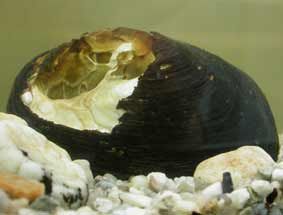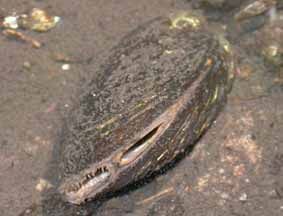Major Group: Bivalvia
Order: Unionida
Family: Hyriidae
This order is represented in Australia by a single family, Hyriidae. |
Descriptive Features: facies variable, with beaks and shell sculpture variously developed
hinge ranges from primitively lamellar to strong, unionid type, sometimes reduced, cardinal teeth generally erect and grooved
siphons generally may be well developed and prominent or not prominent or protruding, if prominent then supra-anal and anal siphons fused, mantle bridge between anal and branchial siphons well developed, branchial siphon rarely closed below, gill diaphragm medium to long
marsupium in inner gills, variously developed
anterior retractor and adductor muscle scars fused or separate, as a deep pit beneath the cardinal
cardinal teeth very erect, grooved, serrated, and frequently denticulate
supra-anal opening absent
glochidium, subtriangular, hooked
Size: variable |

|
Alathyria condola |
|
|

|
Velesunio angasi |
|
Taxonomic Checklist: Genera
Alathyria
Cucumerunio novaehollandiae Gray
Hyridella
Lortiella
Velesunio
Westralunio carteri Iredale |
|
Distribution: all states
Sensitivity Rating: SIGNAL grade 5
Functional Feeding Group: filtering collectors
|

|
Broken River, Benalla Vic |
|
|
Ecology: Instream habitat: Hyriidae species are widespread in lowland river systems except in ephemeral, saline or low-calcium waters. They burrow into finer sediments such as sand and mud. Some Hyriidae species can tolerate low dissolved oxygen, high temperatures and drought.
Feeding ecology: Bivalvia species are filter feeders that feed by leaving the hind portion of the shell exposed to the water column, to allow a pair of siphons to pump water into the shell where food is absorbed and then rubbish expelled. They are not selective, feeding opportunistically on unicellular algae and plant detritus suspended in the water. Bivalvia can play a significant role in local food webs by increasing the flux of organic and inorganic matter to riverbeds, which in turn influences macroinvertebrates assemblages
Habit: Hyriidae species use a muscular foot to drag their shell below the surface of the sediments or along the stream bed. Hyridella depressa has been recorded from burrows extending to 20 metres.
Life history: Spermatogenesis generally occurs throughout the year but reduces with temperature during June and July. Intensive production of spermatozoa occurs during November until late April. Spawning occurs from late March to April. Eggs are moved into specialised portions on the inner gills (marsupia) where they develop into a hooked larval stage (glochidium). The brooding season generally extends from April to August. Mature glochidia are generally released nine weeks after spawning. The period between August and November is a recovery period in which unspawned gametes are either reabsorbed or released. Mature glochidia spend little time in the water column, they quickly attach to the gills or fins of a fish host. The reproductive cycle of Hyridella extends throughout most of the year and it is possible that some species breed more than once per year. Hyridella depressa is a long term brooder developing glochidia in the marsupia for up to eight months. Hyriidae species are relatively long-lived among bivalves. In New Zealand, Hyridella live from 7 to 33 years. Velesunio in Australia are thought to live up to 60 years. |
| |
Information Sources: Smith 1992, 1996, McMichael & Hiscock 1958, Walker 2004, Walker et al. 2001, Gooderham & Tsyrlin 2002, Box et al. 2006, Jones et al. 1986, Byrne 1998, Hughes et al. 2004
Key to Genera: Walker 2004
Key to Species: Walker 2004 |
|
|
|